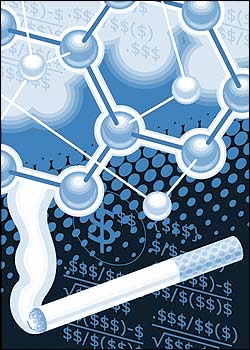Biotech fever has infected the Legislature. Gov. Christine Gregoire’s proposed $350 million Life Sciences Discovery Fund sailed through the state Senate with a bipartisan vote, 45-4, on Friday, March 11. There was hardly any debate on the controversial claim that ESSB 5581 will produce 20,000 jobs over the next 10 years. Now the fund is following a similar trajectory in the state House, although some representatives, including Maralyn Chase, D-Edmonds, are trying to boost the financial return on the public’s investment.
Starting in 2008, Washington will receive an additional $50 million annually for 10 years from the $200 billion settlement between 46 states and tobacco companies. The bonus—on top of $4 billion the state gets as a participant in the overall settlement—is acknowledgment of Gregoire’s key leadership as state attorney general in the landmark agreement. The Life Sciences Fund would essentially be a granting agency that could dole out up to $35 million of that bonus annually over the 10-year period to researchers at state institutions like the University of Washington and nonprofits like the Fred Hutchinson Cancer Research Center. For-profit companies could help pay for research by matching grant money but could not directly apply for money from the fund. Under the state Senate’s version, an 11-member board of four legislators and seven citizen trustees, one of whom must be experienced in agricultural research, would administer the fund and decide which scientists would receive money. The fund’s board is supposed to take several criteria into consideration when deciding on which grants are worthy: quality of proposals, health care benefits, geographic diversity within Washington, evidence of private and public collaboration, and the potential for leveraging additional funding and stimulating employment, according to state House staff reports. While the first two criteria don’t raise any questions, all the rest of them do.
The governor herself has been all over the map on these issues before arriving at this plan. In 2003, House Technology Chair Jeff Morris, D-Anacortes, sponsored a bill that created a similar fund. Then– Attorney General Gregoire opposed the idea, arguing that the tobacco settlement money should be reserved for public health and smoking-prevention efforts. Those concerns are still valid, although Gregoire doesn’t mention them anymore. Sister Sharon Park, executive director of the Washington State Catholic Conference, says her organization is trying to keep them alive. “We don’t have any objections to having money for research, but not when we are cutting health care for the poor,” says Park. Changes in federal and state policies have eliminated health insurance for 62,000 poor Washington children in the past three years, according to the Children’s Alliance, an advocacy group.
The concern for the poor did not resonate in the Senate. Instead, a full-court lobbying press by the governor and the biotech industry, including superstar scientist Leroy Hood, convinced lawmakers of the economic benefits of the Life Sciences Discovery Fund. Gregoire and her staff regularly say it will create 20,000 new jobs over the next 10 years. The governor has dialed back the hype somewhat since the campaign last fall, when she talked about investing all $500 million of the state’s bonus to produce 68,000 to 100,000 new jobs.
Washington has a workforce of more than 3.2 million. The Washington Biotechnology and Biomedical Association, a trade group, claimed in a 2002 study that 190 life-sciences companies employed 19,360 workers. The state’s Employment Security Department says 509 companies doing research and development in the physical, engineering, and life sciences employed 16,643 workers as of 2004—an increase of 143 workers over the previous year. Clearly, the life sciences are not a big employer in Washington. Just compare them to the latest employment figures for aerospace (64,100) or transportation equipment (76,700).
Life sciences already receive enormous amounts of government money, funding that dwarfs Gregoire’s proposal. The National Institutes of Health (NIH) provide $400 million annually in research grants to the Seattle area alone, according to Joseph Cortright, an independent Oregon economist and co-author of an influential study on how cities and states are pursuing biotech. Cortright points out that Gregoire’s proposal would be less than a 10 percent increase in funding, yet she promises to double biotech’s statewide employment. He argues that $350 million covers only 350 more jobs, because the cost of funding one researcher and his or her lab is conservatively estimated to be around $100,000 per year, if not more. While there would be other jobs created by the presence of those 350 researchers—economists call this the multiplier effect—each of those 350 jobs would only last as long as the grant money did.
Marc Baldwin, Gregoire’s executive policy adviser on economic development, says Cortright is ignoring the potential of matching grants from corporations, nonprofit foundations, and government agencies. “The actual amount is close to $1 billion” over 10 years, says Baldwin, not just the $350 million in state money.
Cortright notes that NIH does not give out matching grants. And even if Baldwin’s optimistic prediction is true, $1 billion over 10 years only represents 25 percent more funding for biotech than the NIH’s $4 billion over the same period, and yet the governor is claiming this 25 percent additional investment would mean 100 percent more jobs. If economic development were that easy, there would be no such thing as unemployment.
Cortright says the requirement for geographic diversity also concerns him. Obviously, this criterion was included to make the measure more politically palatable to Eastern Washington. The Life Sciences Discovery Fund’s proponents frequently mention Pullman’s Washington State University and Richland’s Pacific Northwest National Laboratory as potential grant recipients. Cortright says the grants will be most likely to result in economic development if they are targeted to the area of the life sciences where Washington already has a competitive advantage. “If [the money] is peanut butter spread evenly across the state, it doesn’t have a huge impact,” says Cortright.
Baldwin insists the money will be used effectively. “The proposal is built on research where Washington has a strategic advantage—medical instruments and software in medical applications,” he says. Language added to the bill in the Senate does more specifically define life-sciences research, but the Senate also added the requirement that one of the fund’s trustees be experienced in agricultural research, which indicates an expansion of the intent rather than a narrowing.
The legislation now moves to the state House, and Morris says his committee will tighten up the legislation considerably so that it promotes Washington’s strength—the convergence of software, hardware, and biomedical science. “We are trying to hone it down to this predictive and preventative medicine,” he says. Morris claims this will not exclude Eastern Washington, because the Pacific Northwest National Lab has a life-sciences unit, and WSU’s agricultural and animal research can have applications to predictive and preventative medicine.
Unfortunately, few legislators are asking questions about the Life Sciences Discovery Fund and seem to have bought the hype. A few conservative Christian Republicans are worried about the potential for funding stem-cell research, but the GOP is silent on science pork. In the state House, state Reps. Steve Conway, D-Tacoma, Dawn Morrell, D-Puyallup, and Chase are working to amend the bill to give the public “an equity position” in any discoveries that have commercial success.
The fund is accompanied by legislation that would loosen the prohibition on collaborations between professors at state universities and private corporations. SSB 5811, known as the Tech Transfer bill, would allow professors to sell their research to companies that are interested in commercial applications. The biotech fund granting criteria also stress the need for public-private partnerships. Currently, state law directs universities to develop policies for technology transfer. While most state universities have done so, Morris says a single, statewide policy would be beneficial. “Everybody feels we can do better,” he says.
Chase wants any discoveries that are paid for with public money and successfully commercialized to pay money back to the state. “A blockbuster drug could help support the general fund,” she says. “I hope they can do wondrous things with this research, but we have a responsibility to the taxpayers.” Chase admits that it is proving difficult to find the votes in her caucus and to write the complex law needed to guarantee taxpayers such a return.
Morris thinks it’s a waste of time. “The state will be getting an indirect return in jobs and tax revenues,” he says. “Squabbling over the state’s equity position doesn’t help us in the long run.”
Chase points out that in 2003 the University of Washington entered into an agreement with the China-based Holley Group to commercialize and develop artemisinin, a promising cancer drug. She sees that as evidence that once jobs get to the manufacturing stage, they are shipped overseas, and the public is not properly compensated for its startup investment. Asks Chase, “We don’t get jobs out of this, so why don’t we get an equity position?”








